Edit: Added data.
As a previous Stata-user and coding-newbie I'm having fun & trouble with the transition to R. I'm trying to make a line plot based on some of the variables in the dataframe seen in the screenshot. I've got the lines going the way I want them to, but adding a simple legend where I get to label each linetype is not at all going well. I can't even get a legend to show up! I'm fairly certain I'm not getting the level of abstraction used by ggplot here, but I'm also completely certain I want to specify this stuff manually to get the format right across multiple graphs for the publication.
By all means tell me if my whole approach is wrong, but if there is a line or two I can add that clears this up instead of adding more levels of abstraction I'd be a very happy camper.
(I have tried many solutions from similar questions on Stack Overflow and elsewhere, but I'm just not getting it.)
codingsuccess <- ggplot(data = ystats, aes(x=iyear)) +
geom_line(aes(y = pnattacks), linetype = "dotted", size = 1) +
geom_line(aes(y = ptra), linetype = "longdash", size = 1) +
geom_line(aes(y = pdom), linetype = "F1", size = 1) +
geom_line(aes(y = punc), linetype = "solid", size = 1) +
labs(title = "Coding Success", x = "Year", y = "Percentage") +
theme_bw()
codingsuccess # View plot
Data
structure(list(pnattacks = c(96.6954022988506, 94.229722373435,
95.4063604240283, 93.9429464634623, 94.5975744211687, 96.4044943820225,
96.3838166845686, 93.6634494334872, 92.4137931034483, 95.6087824351297,
89.628349178911, 93.6086529006883, 93.4337997847148, 95.7178841309824,
93.8461538461539, 96.2779156327543, 95.0248756218905, 96.039603960396,
96.7592592592593, 96.1538461538462, 96.219035202086, 95.4599761051374,
86.3636363636364, 94.058229352347, 95.1696377228292, 94.8897256589564,
93.6298076923077, 91.9762258543834, 87.6906318082789, 89.1412056151941
), ptra = c(91.6216216216216, 94.2408376963351, 94.6564885496183,
90.9090909090909, 87.7952755905512, 94.5887445887446, 97.5450081833061,
96.7051070840198, NaN, 97.6311336717428, 93.2668329177057, 95.9090909090909,
93.3920704845815, 99.4413407821229, 97.0588235294118, 98.7421383647799,
95.4022988505747, 98.4455958549223, 95.852534562212, 95.4022988505747,
94.9074074074074, 94.6341463414634, 93.1578947368421, 94.5205479452055,
94.0639269406393, 88.5826771653543, 91.554054054054, 89.3041237113402,
85.7374392220421, 91.2866449511401), pdom = c(98.116539140671,
97.3818181818182, 98.1110475100172, 97.2609561752988, 97.7892756349953,
98.0813953488372, 97.5047080979284, 95.0148367952522, NaN, 96.2833914053426,
94.4610778443114, 94.6575342465753, 94.4532488114105, 99.5024875621891,
92.375366568915, 96.4285714285714, 98.0952380952381, 96.9072164948454,
97.2027972027972, 98.1060606060606, 97.9779411764706, 98.3660130718954,
96.9072164948454, 95.5916473317865, 98.2203969883641, 97.3514211886305,
95.5904334828102, 94.8237394020527, 88.2456915598763, 88.370142577579
), punc = c(15.8536585365854, 23.1884057971014, 41.5730337078652,
0.641025641025641, 25, 20.7920792079208, 19.8412698412698, 22.5641025641026,
0, 31.9587628865979, 21.0526315789474, 43.4782608695652, 49.5867768595041,
10.5263157894737, 7.69230769230769, 9.09090909090909, 0, 40,
8.69565217391304, 0, 0, 7.31707317073171, 0.75187969924812, 1.96078431372549,
14.2857142857143, 25.1968503937008, 7.01754385964912, 50.6398537477148,
60.5584642233857, 73.558981233244), iyear = 1985:2014), .Names = c("pnattacks",
"ptra", "pdom", "punc", "iyear"), row.names = c(NA, 30L), class = "data.frame")
